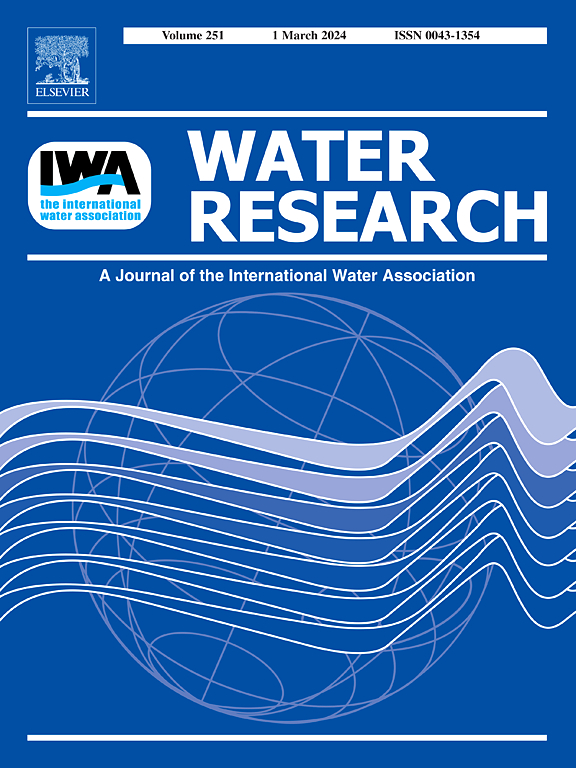Fingerprinting Complex Mixed Oil Spills at Refineries: Source Identification, Quantitative Source Apportionment, and Biodegradation Assessment
IF 12.4
1区 环境科学与生态学
Q1 ENGINEERING, ENVIRONMENTAL
引用次数: 0
Abstract
Chemical fingerprinting is well-established for source identification of marine oil spill, however cases for contaminated industrial sites are much more complicated. This study applied an integrated framework (combining source identification, source apportionment, and biodegradation assessment) for a forensic investigation of a 50000 m2 Light Non-Aqueous Phase Liquid (LNAPL) plume. Comprehensive analysis of 28 samples (16 floating oils, 10 petroleum products, 2 crude oils) revealed four distinct oil mixtures within the LNAPL plume, each comprising varying proportions of reformulated gasoline, catalytic cracking diesel, straight-run diesel, and crude oil. More importantly, this work makes three key methodological advances: (1) We developed a new source apportionment method to quantify oil mixing ratio of ternary oil mixtures (gasoline-diesel-crude oil). The new method overcame the limitations of conventional biomarker-based approaches that was not applicable to light distillates or multi-source contamination; (2) A novel biodegradation index (BdgrI) was developed to reconcile source-specific mixing ratios with conventional biodegradation ratio, enabling standardized assessment of biodegradation degree in oil mixtures; (3) We also demonstrated that the commonly used biomarker “bicyclic sesquiterpanes” were unable to achieve accurate source identification for middle distillates with the same crude oil feedstocks and similar distillation cut temperatures, since the distribution characteristics of bicyclic sesquiterpanes in crude oil were “inherited” by middle distillates with similar distillation cut temperatures, even if they were processed through different refining technologies. These innovations significantly enhance forensic capability for complex petroleum contamination, improving source identification accuracy, guiding targeted bioremediation strategies, and providing quantitative scientific support for environmental liability allocation and remediation cost-sharing at contaminated refinery sites.

炼油厂复杂混合溢油的指纹识别:来源识别,定量来源分配和生物降解评估
化学指纹识别技术在海洋溢油源识别方面已经得到了广泛的应用,但在工业污染场地的情况则要复杂得多。本研究采用综合框架(结合源识别、源分配和生物降解评估)对50000 m2轻非水相液体(LNAPL)羽流进行法医调查。对28个样品(16个浮油,10个成品油,2个原油)的综合分析显示,LNAPL羽流中有四种不同的石油混合物,每种混合物由不同比例的再配方汽油,催化裂化柴油,直馏柴油和原油组成。更重要的是,本工作取得了三个关键的方法进步:(1)我们开发了一种新的源分配方法来量化三元油混合物(汽油-柴油-原油)的油混合比。新方法克服了传统的基于生物标志物的方法的局限性,这些方法不适用于轻馏分或多源污染;(2)建立了一种新的生物降解指数(BdgrI),以协调源特异性混合比和常规生物降解比,从而实现对混合油生物降解程度的标准化评估;(3)我们还证明了常用的生物标志物“双环倍半萜烯”无法对具有相同原油原料和相似蒸馏切割温度的中间馏分油进行准确的来源识别,因为即使经过不同的精炼工艺,原油中双环倍半萜烯的分布特征也会被具有相似蒸馏切割温度的中间馏分油“继承”。这些创新显著增强了复杂石油污染的法医鉴定能力,提高了来源识别的准确性,指导了有针对性的生物修复策略,并为污染炼油厂的环境责任分配和修复成本分担提供了定量的科学支持。
本文章由计算机程序翻译,如有差异,请以英文原文为准。
求助全文
约1分钟内获得全文
求助全文
来源期刊

Water Research
环境科学-工程:环境
CiteScore
20.80
自引率
9.40%
发文量
1307
审稿时长
38 days
期刊介绍:
Water Research, along with its open access companion journal Water Research X, serves as a platform for publishing original research papers covering various aspects of the science and technology related to the anthropogenic water cycle, water quality, and its management worldwide. The audience targeted by the journal comprises biologists, chemical engineers, chemists, civil engineers, environmental engineers, limnologists, and microbiologists. The scope of the journal include:
•Treatment processes for water and wastewaters (municipal, agricultural, industrial, and on-site treatment), including resource recovery and residuals management;
•Urban hydrology including sewer systems, stormwater management, and green infrastructure;
•Drinking water treatment and distribution;
•Potable and non-potable water reuse;
•Sanitation, public health, and risk assessment;
•Anaerobic digestion, solid and hazardous waste management, including source characterization and the effects and control of leachates and gaseous emissions;
•Contaminants (chemical, microbial, anthropogenic particles such as nanoparticles or microplastics) and related water quality sensing, monitoring, fate, and assessment;
•Anthropogenic impacts on inland, tidal, coastal and urban waters, focusing on surface and ground waters, and point and non-point sources of pollution;
•Environmental restoration, linked to surface water, groundwater and groundwater remediation;
•Analysis of the interfaces between sediments and water, and between water and atmosphere, focusing specifically on anthropogenic impacts;
•Mathematical modelling, systems analysis, machine learning, and beneficial use of big data related to the anthropogenic water cycle;
•Socio-economic, policy, and regulations studies.
 求助内容:
求助内容: 应助结果提醒方式:
应助结果提醒方式:


